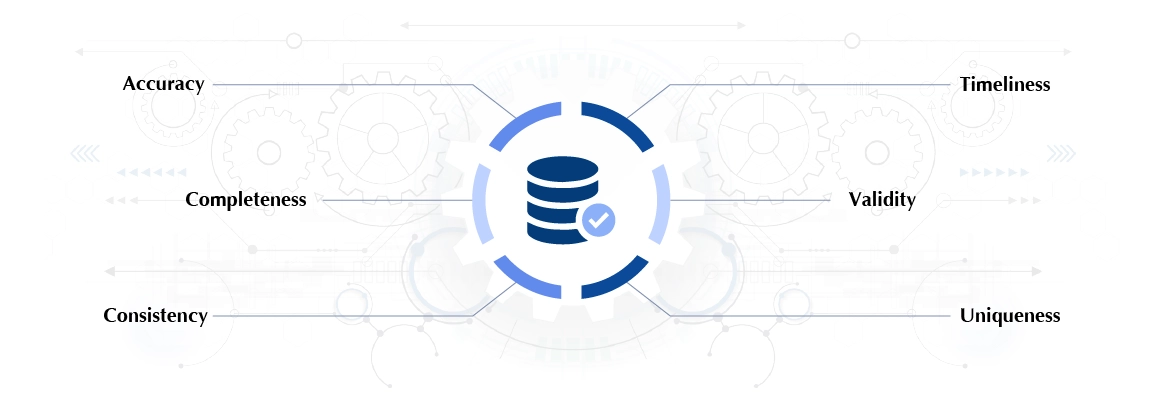Data quality refers to the state of data. It is measured by factors like accuracy, completeness and reliability, and whether it is up-to-date. Organizations can use data quality measurements to identify potential data errors and determine if their IT systems can fulfil their intended purpose.
As data processing becomes more complex and linked to business operations, the importance of data quality best practices has increased. Organizations increasingly use data quality tools for business decision-making. Data quality management is an integral part of data management. Data governance programs are closely linked to data quality improvement efforts that ensure consistent use of data metrics throughout the organization.
Data quality is the application of quality management techniques to data to ensure that it meets the needs of an organization. High-quality data is data that has been deemed suitable for its intended purpose.
Data quality enhancement is about establishing and following a set of agreed-upon rules and standards that govern all data within an organization. Data governance must harmonize data from different sources, establish and monitor data usage policies and eliminate inconsistencies or inaccuracies that could negatively impact data analytics accuracy.
Companies can be severely affected by bad data. Poor data quality is often blamed for operational problems, inaccuracy in analytics, and poor business strategies. Data quality issues can lead to additional expenses, lost sales opportunities, or fines for financial reporting not in compliance with regulatory requirements.
Six data quality fundamentals to achieve data quality goals and objectives.
Data must be consistent with real-world scenarios and should reflect real-world objects or events. Analysts must use verified sources to verify the accuracy of the data. This is determined by the degree of agreement between the values and the correct information sources.
Completeness is the ability of data to provide all required values successfully.
Data consistency refers to the maintenance of uniform data as it moves through applications and networks and comes from multiple sources. Point-in-time consistency refers to the ability to ensure that all elements in a system are identical at a particular moment in time. This helps prevent data loss during network crashes and improper shutdowns.

It is data that is available at all times. This dimension also includes keeping data current. Data should be updated in real-time to ensure that it is always accessible.
Data collection must follow the company's business rules and parameters. All data must be in the right formats and within the acceptable range.
Uniqueness is the absence of duplicates or redundant information across all datasets. There is no record in the data that has been duplicated. Analysts use data cleansing and deduplication to address low uniqueness scores.
Many companies face Challenges with Bad Data. The problem is often more serious than they realize. Organizations may neglect to implement data quality assurance procedures such as standards and criteria to speed up data collection and optimize programs in real time. This can lead to an overreliance on incorrect, incomplete or redundant data. It can also create a domino effect of incorrect numbers and metrics.
Organizations are working with large amounts of big data, and many don't have the data science resources to correlate these data. Organizations will not be able to make time-sensitive optimizations if they don't have the right Data Quality Tools and analysts to sort these data.
One study found that only 3% of executive respondents had data records within acceptable limits. Marketers are also concerned about Data Quality Benchmarks, with 65 per cent listing it as a priority. Six out of ten marketers keep improving Data Quality Attributes at the top of their priorities list. Bad data can have the following consequences:
It is not surprising that all organizations are focused on improving data quality. These are 12 steps that your company can take to improve your data quality and increase your business' effectiveness and efficiency.
1. Take Stock of Your Data
You must first understand the data that you have before, to improve its quality. To do this, you need to conduct a formal data quality assessment.

2. Define acceptable data quality
It is also important to determine acceptable data quality for your organization. How accurate and relevant can data be if they are not 100% accurate? Different data quality standards (DQ) may be needed for different types of data and different uses.
3. Correct Data Errors Up Front
Any Data Quality Management (DQM) initiative should include identifying and resolving data problems. DQM is made easier if you ingest clean data. This means that systems must be designed to ensure accurate data entry and flag incorrect or incomplete records before they are entered into the system.
4. Eliminate Data Silos
Large enterprises often have data silos in different locations or departments. It can be difficult to get a complete view of your company or locate all your data. Data quality problems can also be caused by data silos that operate independently and have their own rules. To make your data more accessible and ensure that all data is subjected to the same DQM processes, you need to centralize it.
5. Data accessible to all users
Data silos can also lead to the unintended consequence of removing valuable data from employees who need it. The data you collect must be high quality and easily accessible to many potential users. This is why cloud-based file sharing is a good option for employees, especially remote workers.
6. Use the correct data
You collect a lot of data for your organization, but are you getting the right information? You must also make sure you choose the correct input for your analyses. Accessing a wide range of resources and filtering out the ones not pertinent to your current needs is important. It is important to capture the right data at the beginning - your data collection efforts should reflect your future data needs.
7. For common data, impose a defined set of values.
Users entering unstructured data can lead to many data errors. You might allow users to input a state name manually. You might have users type "MN", "Minn," or "Minnesota", and then others misspell it. This can lead to serious errors in your data. Instead, give users a list of common values or options to select the appropriate state abbreviations from a drop-down menu. This will provide a more consistent and cleaner data set than other methods.
8. Protect Your Data
It is your responsibility to protect valuable data from unauthorized access. You must comply with all privacy regulations to ensure that customer data is not misused. This is particularly important for protecting against cyberattacks and data breaches and ensuring that the data cannot be edited or compromised by unauthorized users. You need to use multiple data security methods while still allowing access to authorized users within your organization.
9. Promote a data-driven culture
Effective data quality improvement requires participation from all employees, including the C-suite and administrative pool. Regular training should be conducted on data quality and key DQM processes.
10. Designate a Data Steward
A data steward is someone who oversees data quality management in your company. The data steward should be responsible for analyzing your data quality and conducting regular DQ reviews. They also need to implement new DQM methods. Your data steward must also be able to train your staff in DQM techniques and improve DQ over time.
11. Do regular DQ reviews
You should also conduct periodic reviews of your organization's data quality to ensure that they remain effective. These reviews will let you know if your organization is making progress and where you need to improve. These reviews should fall under the control of your data steward.
12. Use a robust data quality management solution
An automated data monitoring system such as Data Buck by First Eigen is one of the best ways to improve your company's data quality framework. Automated DQM platforms automatically analyze your data and identify any issues. Then, they "clean up" or delete bad data. This DQM platform is much faster and more efficient than manually doing it.